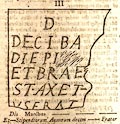







 next page
next pageperstes is a name that occurs in Gruter (f).
The appellation Postumiana ascertains the time of these inscriptions, for Gallienus began to reign alone about the year 259, which, as appears from Trebellius Pollio, was before Postumius was made emperor in Gaul (g). We may therefore reasonably suppose the time of these inscriptions to have been between the years 260 and 267 or 268. I chose Tribunus to compleat the first inscription, because in other inscriptions, this Cohort appears to have been commanded, not by a Praefect, but by a Tribune (h). Of these stones I have only taken the planes, on which the inscriptions are, as I saw nothing else observable in them. The ligature of the EC, if I have taken that part of the first inscription right, is worth observing.


Dis Manibus - - - Et - Stipendiroum Annorum decem - Frater
III. This stone lies upon a wall just by a gate at a little distance from the station westward. The letters are well cut, and are deep in the stone. Half of it, if not more, seems to be broken off; so that very little can be known about it, which is a great pity. However, it plainly appears to have been a sepulchral; but of the DM for Dis Manibus the D only is left on the top. An inscription in Gruter tells us of a Cohors Bracarum that was once in Britain (i); but that the same Cohort is intended here under the name Braecarum, I will not say. All that can be said about it is, that the person, to whom that belonged, seems to have served ten years in the army, and that it has been erected to him by his brother. For STAX seems to denote Stipendiorum Annorum decem; and the last four broken letters of the last line plainly appear either to have stood for Frater, or to hev been part of the whole word. The stroke near the T, in the last line but one, seems only to be an accidental scratch upon the stone.


--- Centuriae Marii Cohortis quartae Brittonum Antoniniae viator - Hoc Sepulchrum faciendum curavit.
IV. This and the following I met with at the farm house at Carrvoran, at or near which they were found a few years since. This, I make no doubt, is sepulchral. At first, indeed, from the centurial mark at the beginning, one might be apt to take it for an inscription of the centurial kind. But where there are spaces between two diverging lines, or ridges on the borders of inscribed stones, they are always on the middle of the borders; from whence it appears, that what is now first cannot have been the original beginning of the inscription; and that about two lines may well be supposed to have been broken off from the upper part of it, which probably have contained the name of the deceased, and his rank in the army. What remains shews his belonging to the century of one, the three first letters of whose name were MAR, as Marius or Marcus &c. What was next in the first remaining line is broken off; and so is something from the two succeeding ones. This leaves us not a little in the dark; and yet, I think, we have reason to conclude, and with some degree of probability too, that the Cohort, to which the deceased belonged, was the Cohors quarta Brittonum Antoninia. Mr Horsley, in his collection of sculptures and inscriptions, has given us a part of the body of an altar erected by one of this Cohort (k). He is not, indeed, certain at what particular place it was found; but he is inclined to believe, that it was somewhere hereabouts, which occasioned his placing it in the order he has (l). It was of Mr Warburton's collection, and taken to the library at Durham. The inscription, under consideration, suits well with this reading, and better, I think, than with any other. For, if we suppose any other Cohort intended, it must have been entirely included in what is wanting of the first remaining line; the consequence of which will be, that the letters in the second remaining line are the first of the proper name of the person, who took care to have the monument erected: and on this supposition we shall have Viator in the third, as signifying this office. For the Viator is well known to have been a kind of beadle, that attended several of the civil magistrates (m). It occurs in many inscriptions in Gruter, as denoting this officer; but not above two or three of them
(g) Cumque liudibriis et belluationi vacaret (Gallienus) &c. Galli --- Postumium ad imperium vocarunt. Treb. Poll. Gallieni duo.
(h) See Cambden, Horsey.
(i) P. ccccxiv. 8.
(k) Northumberland, lxxvi.
(l) Pag.233.
(m) See Rosini Antiquit. Roman. cum notis Dempsteri p.540 et 542, and Kennet's Roman Antiquities, p.116, 120.

 are
are


 Gents Mag 1752 p.107
Gents Mag 1752 p.107